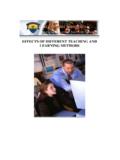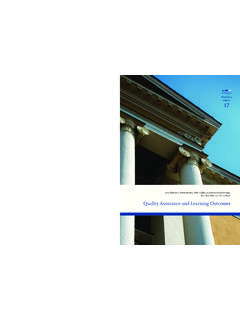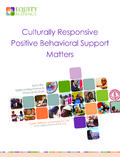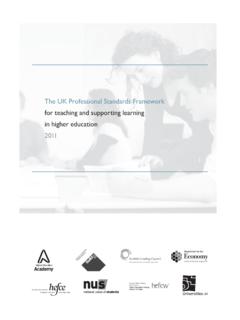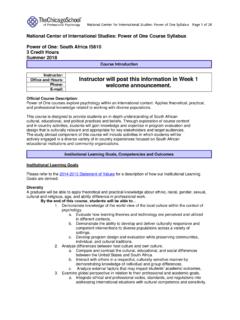Transcription of EDUCATION POLICY OUTLOOK LATVIA - OECD.org - OECD
1 EDUCATION POLICY OUTLOOK . LATVIA . EDUCATION POLICY OUTLOOK : LATVIA OECD 2017 1. March 2017. EDUCATION POLICY OUTLOOK . This POLICY profile on EDUCATION in LATVIA is part of the EDUCATION POLICY OUTLOOK series, which presents comparative analysis of EDUCATION policies and reforms across OECD countries. Building on the OECD's substantial comparative and sectoral POLICY knowledge base, the series offers a comparative OUTLOOK on EDUCATION POLICY by providing analysis of individual countries' educational context, challenges and policies ( EDUCATION POLICY profiles), analysis of international trends and insight into policies and reforms on selected topics. In addition to country-specific profiles, the series also includes a recurring publication. The first volume, EDUCATION POLICY OUTLOOK 2015: Making Reforms Happen, was released in January, 2015.
2 Designed for POLICY makers, analysts and practitioners who seek information and analysis of EDUCATION POLICY taking into account the importance of national context, the country POLICY profiles offer constructive analysis of EDUCATION POLICY in a comparative format. Each profile reviews the current context and situation of the country's EDUCATION system and examines its challenges and POLICY responses, according to six POLICY levers that support improvement: Students: How to raise outcomes for all in terms of 1) equity and quality and 2) preparing students for the future. Institutions: How to raise quality through 3) school improvement and 4) evaluation and assessment. System: How the system is organised to deliver EDUCATION POLICY in terms of 5) governance and 6) funding. Some country POLICY profiles contain Spotlight boxes on selected POLICY issues.
3 They are meant to draw attention to specific policies that are promising or showing positive results and may be relevant for other countries. This country profile also includes a Spotlight on the European Union perspective for LATVIA , based on challenges and recommendations identified by the Council of the European Union and the European Commission, as part of their activities with EU member countries. Special thanks to the Government of LATVIA for its active input during consultations and constructive feedback on this report. We also thank the European Commission for its valuable analytical and financial support for development of 11 OECD-EU Country Profiles published from 2015 to 2017. Authors: This country POLICY profile was prepared by Bojana Jankova, Diana Toledo Figueroa, Gillian Golden and Manon Giovinazzo, from the EDUCATION POLICY OUTLOOK team, part of the POLICY Advice and Implementation Division led by Paulo Santiago.
4 Marco Kools also contributed during the revision of the document. Susan Copeland and C lia Braga-Schich provided editorial support. This profile builds on the knowledge and expertise of many project teams across the OECD's Directorate for EDUCATION and Skills, to whom we are grateful. Marco Montanari and M nika K pe-Holmberg contributed on behalf of the European Commission Directorate-General for EDUCATION and Culture. Sources: This country profile draws on OECD indicators from the Programme for International Student Assessment (PISA), the Teaching and Learning International Survey (TALIS) and the annual publication EDUCATION at a Glance, and refers to country and thematic studies such as OECD work on early childhood EDUCATION and care, teachers, school leadership, evaluation and assessment for improving school outcomes, equity and quality in EDUCATION , governing complex EDUCATION systems, vocational EDUCATION and training, and tertiary EDUCATION .
5 Much of this information and documentation can be accessed through the EDUCATION GPS ( ). Most of the figures quoted in the different sections refer to Annex B, which presents a table of the main indicators for the different sources used throughout the country profile. Hyperlinks to the reference publications are included throughout the text for ease of reading, and also in the References and further reading section, which lists both OECD and non-OECD sources. More information is available from the OECD Directorate for EDUCATION and Skills ( ). and its web pages on EDUCATION POLICY OUTLOOK ( ), as well as on the EU EDUCATION and Training Monitor ( ) and Eurydice ( :Overview). EDUCATION POLICY OUTLOOK : LATVIA OECD 2017 2. TABLE OF CONTENTS. Highlights .. 4. Equity and quality Improving accessibility and affordability for students from disadvantaged backgrounds.
6 7. Preparing students for the future Matching skills with labour market needs .. 9. School improvement A need to make the teaching profession more attractive .. 11. Evaluation and assessment to improve student outcomes Working to improve monitoring 13. Governance A highly decentralised governance 15. Funding New funding models to meet needs in teacher remuneration, system efficiency and demographic changes .. 17. Annex A: Structure of LATVIA 's EDUCATION system .. 19. Annex B: Statistics .. 20. References and further 23. Figures Figure 1. Student performance in science and impact of economic, social and cultural status .. 5. Figure 2. Upper secondary and tertiary attainment of 25-34 year-olds .. 5. Figure 3. Low and top performers and performance difference between non-immigrant and immigrant students .. 8. Figure 4. Population in EDUCATION and not in EDUCATION , by age group.
7 10. Figure 5. School principals' and students' views on learning environment .. 12. Figure 6. Student assessment by purpose .. 14. Figure 7. Expenditure on educational institutions as a percentage of GDP .. 18. Spotlights Spotlight 1. The European Union perspective : LATVIA and the Europe 2020 strategy .. 6. Spotlight 2. Per-student funding and the new teacher remuneration scheme .. 12. Spotlight 3. LATVIA 's EDUCATION priorities 2014-20 and reorganising the system .. 16. Spotlight 4. New funding model for tertiary EDUCATION .. 18. EDUCATION POLICY OUTLOOK : LATVIA OECD 2017 3. HIGHLIGHTS. LATVIA 's educational context Students: In PISA 2015, LATVIA 's performance was slightly below the OECD average in mathematics and reading and close to the OECD average in science, although performance in science decreased between 2012. and 2015.
8 The impact of socio-economic factors on students' performance was below the OECD average. In LATVIA , EDUCATION is compulsory from age 5 to age 16 (including pre-school for 5-6 year-olds). Early childhood EDUCATION and care (ECEC) starts at age , and enrolment rates for 4-year-olds were above the OECD average in 2014 (90%, compared to OECD average of 86%). At upper secondary level, attainment rates are comparatively high, but enrolment and graduation rates for vocational EDUCATION are below the OECD average. Tertiary EDUCATION attainment rates for 25-34 year-olds are around the OECD average. Institutions: Teacher EDUCATION in LATVIA can take two main paths, a four-year bachelor's degree (the more popular option) and a three-year degree followed by a two-year second-level professional programme. Once hired, teachers must do 36 hours of professional development training every three years.
9 Teacher salaries were cut by 50% in 2009 as a result of the economic crisis. Salaries have since recovered, but they are lower than those of other public-sector professionals and below the OECD average. Compared to the TALIS average, fewer teachers in LATVIA think that their profession is valued in society, and a smaller proportion would become teachers if they could decide again. School evaluation combines internal self-evaluation and external evaluation by expert teams appointed by the State EDUCATION Quality Service, a subordinate institution of the Ministry of EDUCATION and Science (MoES). Budget cuts have reduced the frequency and scope of external school evaluations. System: The EDUCATION system in LATVIA is highly decentralised. The MoES is responsible for drafting POLICY and legislation, as well as organising and co-ordinating its implementation.
10 LATVIA has a fragmented regional structure, with 119 municipalities responsible for providing ECEC, primary and secondary EDUCATION closest to students' residences and non-formal EDUCATION . Tertiary EDUCATION institutions have autonomy to design EDUCATION programmes, establish rules and regulations, hire staff and distribute the funding allocated to them. Almost all funding from primary to secondary level, including post-secondary non-tertiary EDUCATION , comes from public sources, a proportion higher than the OECD average. Annual expenditure per student at secondary level was lower than the OECD average in 2013, with large differences in spending between municipalities. Compulsory EDUCATION is free of charge, with the exception of pre-schools, where parents pay for school meals (although there are municipal subsidies for low-income families).










